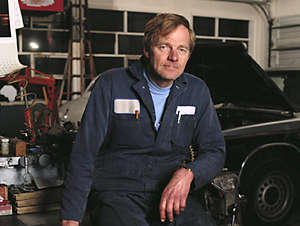
 |
|
 The Car Dealer has an excellent reputation for service behind the sale. We have made our experts available for you to query about any issues or problems you have with mechanics, purchases, brand names and more. Just e-mail your questions to them at ask@thecardealer.com and we'll get right back to you. Here are some selections from recent questions: Q. Our car has starbursts on the paint. They started out as small faded spots in the paint and then spread out. The dealer where she bought the car wants to repaint the entire car but she feels that the seller should foot part of the cost. This problem first surfaced when her car was less than three years old. How long should a person expect the paint to last before it goes to pot? The dealer calls it sun damage and not covered by the manufacturer. A. Auto makers are reluctant to cover paint problems, especially so when the car has a lot of years on it. American auto makers had paint problems in the late '80s and early '90s and it was due to undertested new paint processes that were more environmentally friendly. The only repair is a total repaint since the paint "cancer" is bound to appear on other areas. It's also almost impossible to match faded paint as the new and old paint fades at different rates. You can ask the factory rep (not the dealer) for a repaint, but don't get your hopes up. Q. My car carries a 351 cubic- inch Cleveland engine. It has 153,000 miles on the odometer. The air filter cartridge becomes clogged with motor oil and I then change it. Within a period of two weeks, it becomes clogged again and again I must change it. When the filter becomes clogged with oil, the car performs poorly and it usually stalls in my driveway when I put it in reverse and try to back out of my driveway. When this happens, an oil stain appears on the concrete under the tail pile. I have put in new filters, and changed the positive crankcase ventilation valve. The spark plugs, fuel filter and distributor rotor are all new. A. The only way motor oil can get into the air filter is through the low vacuum side of the sealed positive crankcase ventilation (PCV) system which is routed into the air cleaner. The high vacuum side of the system is controlled by the PCV valve which allows the usually small amount of crankcase fumes to get pulled into the intake manifold and then burned in the combustion chambers. If the crankcase pressure gets too high because of worn-out, damaged or non-sealing piston rings, the PCV high vacuum valve can't handle the volume and the piston blow-by (along with the motor oil fumes it produces in the crankcase) gets pushed into the air intake system where the oil vapors condense and contaminate the air filter cartridge. Do a cylinder leak-down test or a dry-and-wet compression test to see if any or all of the pistons have leaking rings or are cracked. Q. My car has only 59,000 miles. It runs great, except that when I first start it in the morning, it's hard to turn the steering wheel either to the left or to the right. It stays that way until I work it back and forth many times and it gets warmed up. I was told by a mechanic that it has something to do with the front end support of the steering assembly. He said that if I can put up with the problem, it wouldn't hurt anything. Have you heard of this problem? A. Sticking steering is fairly common with products of that era. The problem is in the power-assisted rack-and-pinion steering gear (a sticking hydraulic valve, as I recall). Yours can be repaired but the most common "fix" is to install a rebuilt unit that's readily available at most auto parts stores. Prices vary from area to area, but most of the cars affected are worth the cost of the job Your source of information is correct: it won't suddenly fail, but it can get progressively worse. |
|
|